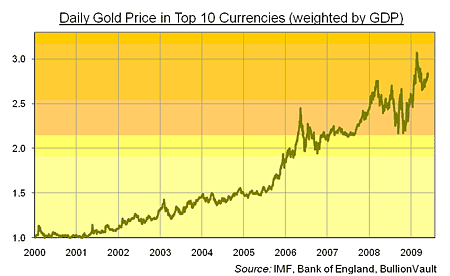The real price of gold
A good indicator of gold's anti-inflation value is its worth versus the world's currencies. And the world's top ten currencies have lost nearly two-thirds of their value against gold since the start of 2000, says Adrian Ash.
One thousand dollars doesn't buy what it used to not for non-US investors, at least.
Back in March 2008, when the gold price first broke $1,000 an ounce, the euro equivalent peaked just shy of €660. Sterling investors here in the UK saw the price touch £515 an ounce.
Yes, both of those figures like the USD gold price were then new record highs. But come the next test of $1,000 per ounce, four months ago in February 2009, the euro price reached 20% higher to touch €795. The UK value-of-gold peaked 35% above that previous $1,000-equivalent, up at £700 per ounce.
MoneyWeek
Subscribe to MoneyWeek today and get your first six magazine issues absolutely FREE

Sign up to Money Morning
Don't miss the latest investment and personal finances news, market analysis, plus money-saving tips with our free twice-daily newsletter
Don't miss the latest investment and personal finances news, market analysis, plus money-saving tips with our free twice-daily newsletter
Today, however, and with analysts watching for less than a 2% move in gold before it re-tests that $1,000 mark for the third time, Eurozone and British investors are well off the mark. February's all-time peaks in euros and sterling stand almost 15% higher from here.
All of which shows what, exactly? First, anti-inflation and crisis insurance just got cheaper for European savers. So second, the $1,000 mark may not prove quite the hurdle it did in March '08 and again in Feb. this year.
But third, and most crucially, the volatile value of US dollars the no.1 reserve currency in central-bank vaults and foreign-trade agreements worldwide is only growing more volatile still as 2009 unfolds.

Quite what this volatility means for the dollar now twice as volatile since March 2008 as its 35-year average who can guess?
But to strip out the noise of dollar up, dollar down... and dollar both up and down at once...the chart above may offer some help.
Updating BullionVault's number-crunching from Gold vs. the World (July 2008), it shows the daily gold price against each of the world's top ten currencies, averaged by weight of the issuing economy (GDP) and indexed back to the start of January 2000.
As you can see, the slide in euro and sterling gold prices since the last record peak hasn't yet made gold cheaper in terms of all major world currencies than it was at the first $1,000 breach. Nor has this decade's bull market to date mirrored just the decline of the dollar, even if the last five weeks' rally has clearly been built on that trend.
The world's money en masse has shed nearly two-thirds of its value in gold since the start of 2000. And we guess here at BullionVault that strong, positive real rates of interest after inflation would be needed to reverse that loss of value in cash and cash-savings worldwide.
Adrian Ash is editor of Gold News and head of research at BullionVault
Get the latest financial news, insights and expert analysis from our award-winning MoneyWeek team, to help you understand what really matters when it comes to your finances.
Adrian has written all things gold related from if it’s worth buying, what the real price of gold should be and what’s the point of gold for MoneyWeek. He has also written for other leading money titles on his gold expertise including Business Insider, Forbes, City A.M, Yahoo Finance and What Investment Magazine. Now Adrian is head of the research desk at BullionVault, a physical market for gold and silver for private investors online.
-
 Why Trustpilot is a stock to watch for e-commerce exposure
Why Trustpilot is a stock to watch for e-commerce exposureTrustpilot has built a defensible position in one of the most critical areas of the internet: the infrastructure of trust, says Jamie Ward
-
 Tetragon Financial: An investment trust with stellar returns
Tetragon Financial: An investment trust with stellar returnsTetragon Financial has performed very well, but it won't appeal to most investors – there are clear reasons for the huge discount, says Rupert Hargreaves